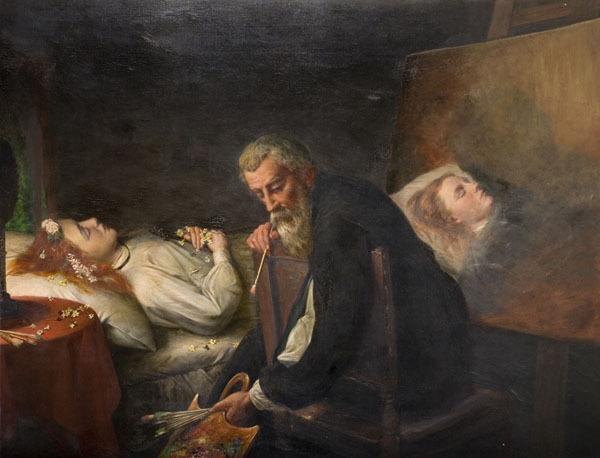Mad from life’s history,
Glad to death’s mystery,
Swift to be hurl’d—
Anywhere, anywhere
Out of the world!
 William James Grant, The Bridge of Sighs, mid 1850s, oil on panel, 5 inches in Diameter
William James Grant, The Bridge of Sighs, mid 1850s, oil on panel, 5 inches in Diameter
If a woman succumbs to society’s condemnation and feels that she cannot live with herself and her shame any longer… then drowning in the Thames is the only option. This is exactly what is portrayed in Grant’s painting “The Bridge of Sighs”. Pale young woman was found drowned, washed on the shores of the Thames, just near the bridge but moments ago. And now the man who found her is holding her frail pale body in his arm and taking her out of the water. Colourful shawl and the white dress are heavy and wet, but not heavier then her heart must have been before she made this decision. Look how lifelessly her arm, head and hair are hanging. The sad heart beats no more. Here is what the same-named poem says of the moment:
Ere her limbs frigidly
Stiffen too rigidly,
Decently, kindly,
Smooth and compose them;
And her eyes, close them,
Staring so blindly!
The theme of a fallen woman was very popular in the Victorian era, especially in the 1850s and 1860s. All members of the Pre-Raphaelite Brotherhod; Rossetti, Millais and Hunt explored the theme, each in his own way, and many other artists followed their example and painted a theme which included exposing the hypocrisy of the Victorian society. It was very easy to be a fallen woman in Victorian era: “Fallen” was therefore an umbrella term that was applied to a variety of women in a variety of settings: she may have been a woman who had had sex once or habitually outside the confines of marriage; a woman of a lower socio-economic class; a woman who had been raped or seduced by a male aggressor; a woman with a shady reputation; or a prostitute. Furthermore, prostitution was defined in a range of ways and the “reality was that hard economic times meant that for many women, prostitution was the only way to make ends meet. Many … were only transient fallen women, moving in and out of the profession (of prostitution) as family finances dictated.’(*)
So this woman wasn’t necessarily a prostitute, she could have also been a working class girl whose lover abandoned her. Or, she could have been a shop worker whose destitute situation compelled her, maybe even once, to prostitution. Once or ten times, she is fallen nonetheless and tainted in the eyes of the respectable world. This painting is the most recent example of this theme that I stumbled upon, and it instantly appealed to me. It’s apparently very small, just little less than 13 cm in diameter. The round shaped canvas with closely cropped figures of the woman’s poignantly painted dead body, two men, and the sinister bridge in the background, along with the frame inscribed with a stanza from Thomas Hood’s poem “The Bridge of Sighs” is just striking. All these artworks are poetic and empathetic views of a bleak theme, and that brings to my mind the kitchen sink drama films which I love so much. In such films, the protagonist is faced with a huge life dilemma. The theme was equally explored in Victorian era literature; we have Charles Dickens’s kind-hearted prostitutes and most importantly Thomas Hood’s poem “The Bridge of Sighs”, published in 1844. The poem tells a story of an anonymous young woman, desperate and abandoned by her lover, pregnant and thrown out of her home, who committed suicide by jumping of off a bridge. Here is the whole poem:
One more Unfortunate,
Weary of breath,
Rashly importunate,
Gone to her death!
Take her up tenderly,
Lift her with care;
Fashion’d so slenderly
Young, and so fair!
Look at her garments
Clinging like cerements;
Whilst the wave constantly
Drips from her clothing;
Take her up instantly,
Loving, not loathing.
Touch her not scornfully;
Think of her mournfully,
Gently and humanly;
Not of the stains of her,
All that remains of her
Now is pure womanly.
Make no deep scrutiny
Into her mutiny
Rash and undutiful:
Past all dishonour,
Death has left on her
Only the beautiful.
Still, for all slips of hers,
One of Eve’s family—
Wipe those poor lips of hers
Oozing so clammily.
Loop up her tresses
Escaped from the comb,
Her fair auburn tresses;
Whilst wonderment guesses
Where was her home?
Who was her father?
Who was her mother?
Had she a sister?
Had she a brother?
Or was there a dearer one
Still, and a nearer one
Yet, than all other?
Alas! for the rarity
Of Christian charity
Under the sun!
O, it was pitiful!
Near a whole city full,
Home she had none.
Sisterly, brotherly,
Fatherly, motherly
Feelings had changed:
Love, by harsh evidence,
Thrown from its eminence;
Even God’s providence
Seeming estranged.
Where the lamps quiver
So far in the river,
With many a light
From window and casement,
From garret to basement,
She stood, with amazement,
Houseless by night.
The bleak wind of March
Made her tremble and shiver;
But not the dark arch,
Or the black flowing river:
Mad from life’s history,
Glad to death’s mystery,
Swift to be hurl’d—
Anywhere, anywhere
Out of the world!
In she plunged boldly—
No matter how coldly
The rough river ran—
Over the brink of it,
Picture it—think of it,
Dissolute Man!
Lave in it, drink of it,
Then, if you can!
Take her up tenderly,
Lift her with care;
Fashion’d so slenderly,
Young, and so fair!
Ere her limbs frigidly
Stiffen too rigidly,
Decently, kindly,
Smooth and compose them;
And her eyes, close them,
Staring so blindly!
Dreadfully staring
Thro’ muddy impurity,
As when with the daring
Last look of despairing
Fix’d on futurity.
Perishing gloomily,
Spurr’d by contumely,
Cold inhumanity,
Burning insanity,
Into her rest.—
Cross her hands humbly
As if praying dumbly,
Over her breast!
Owning her weakness,
Her evil behaviour,
And leaving, with meekness,
Her sins to her Saviour!
Tags: 1844, 1850s, abandoned, art, dead body, dead woman, Death, fallen woman, London, Painting, Pre-Raphaelites, prostitute, Thames, The Bridge of Sighs, Thomas Hood, victorian art, Victorian era, William James Grant
 Léon Cogniet, Tintoretto Painting His Dead Daughter, 1843
Léon Cogniet, Tintoretto Painting His Dead Daughter, 1843







